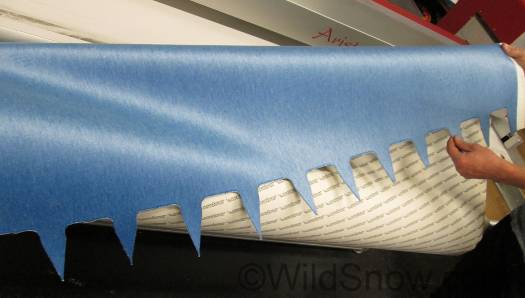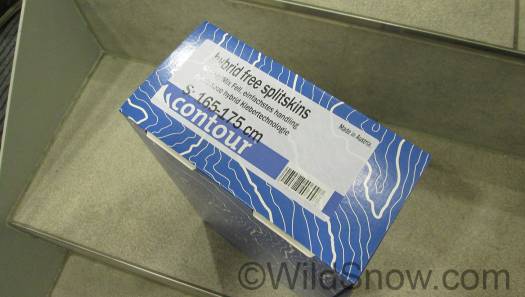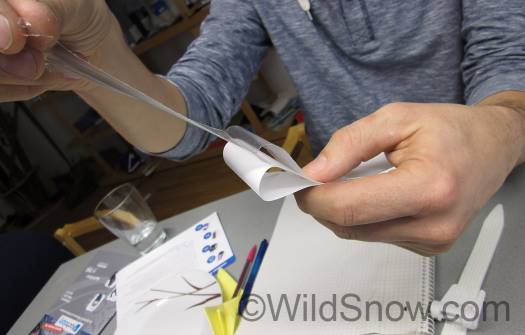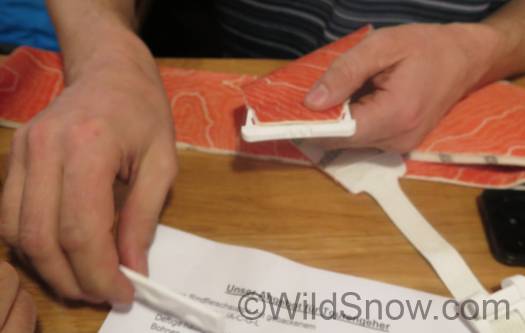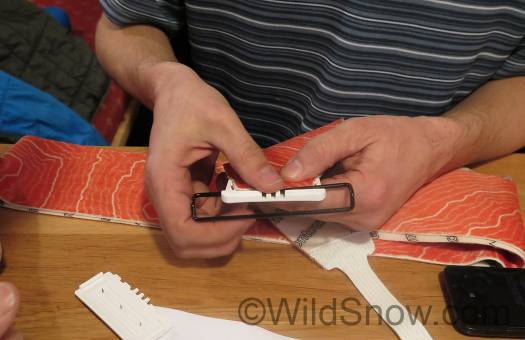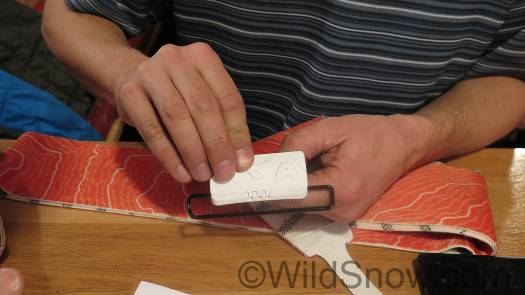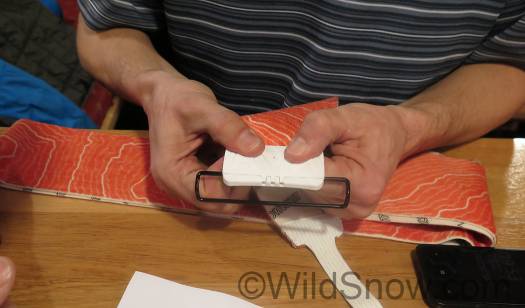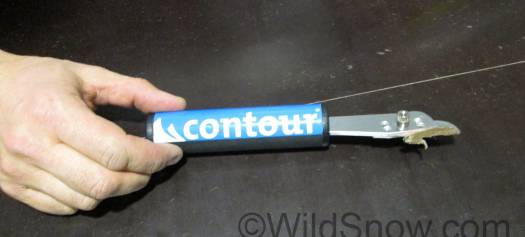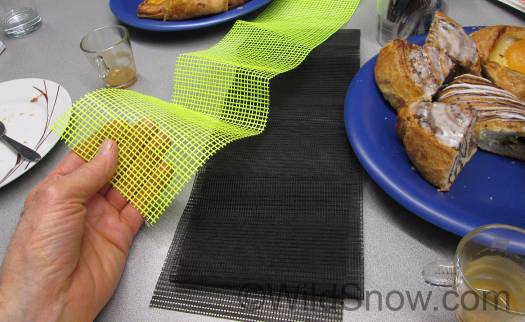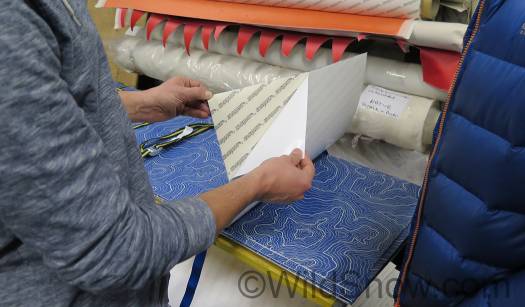Yep, could this be the year of the climbing skins? After a visit to Contour Skins here in Austria, I’m thinking that’s so. Everywhere I turn I’m seeing innovation, and that’s especially true of Contour.
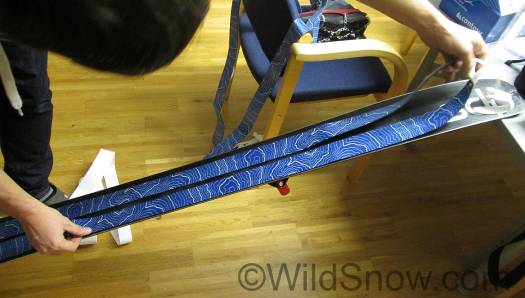
Since the Contour Hybrid glue doesn’t stick to itself very strongly, it works well for a basic split skin with no center section, which with ‘normal’ skin glue would tend to become a huge mess. Conventional one-piece skins are available as well, of course, but the split skin illustrates how versatile this product is. Because these split skins have no center section, they can work for a variety of ski widths. It’s a cool concept that’s been tried before, only in this case enabled by better glue.
These guys (Koch Alpin is the parent company of Contour) have been around the block — they’ve been making and distributing ski touring climbing skins for 40 years. Starting out as partners with well known climbing skin brand Coltex, they actually shared the Coltex brand and manufactured Coltex skins for Austria and Germany. A few years ago they parted with Coltex and began only making skins under their own Contour brand using the same production methods as Coltex, as well as picking up their pace of innovation.
Result: Three years ago Contour went to retail with a way of producing “hybrid” skins with better glue. We’ve been using them. They work. In fact, so far they’re awesome.
At a meeting with Contour a few days ago at their factory near Innsbruck, Austria the Contour owners explained that the challenge with making adhesive climbing skins is that the glue has to stick to the skin backing, as well as having the perfect tack for your ski bases. The two things can be mutually exclusive. Sticky enough to cling to the skin fabric? Perhaps too sticky for storage. More, glues with better temperature range may not adhere correctly to the climbing skin. Solution: use two layers of glue.
Enter the Contour Hybrid glue system. Executing this is quite complex and subject to some trade secrets, but easy to describe. Contour uses two layers of skin glue. A bonding layer sticks to the skin fabric. In turn, a nice layer of “working” glue that’s tuned for ultimate consumer friendliness is stuck to the bonding layer.
This is not a hotmelt system. According to Contour, hotmelt glues as used by the majority of climbing skin makers are very temperature sensitive. They have to be, as you need to melt them to apply them to the skin. The Contour glue is applied in sheets, it is not hot-melt, and can thus be much less temperature sensitive, as well as having a finely tuned “tack” that’s optimal for ski bases without regard to how the glue sticks to the skin backing. Both glue compound layers are chemically stable and have a wide temperature range. After heavy use scrub it with soap and water, or even clean with wax remover.
I have two sets of Contour skins (one their mohair/nylon mix and one pure mohair), already tested in a wide variety of conditions and temperatures. So far they’re living up to expectations. The glue is fantastic, coming apart easily after tack-to-tack storage (said to be totally ok) and adhering adequately while very cold in Colorado. The bane of some other skin brands is that when tuned (sticky) for colder temps they leave residue on the ski bases or eventually become useless goo. So far no problem of that sort with Contour. They’re tip and tail attachment systems are excellent as well.
Out of the box, the Contour tip attachment system comprises a pair of white plastic clips that are amazingly complex for a skin tip fix, but are actually quite effective in a tool-less kind of way. You cut the skin tip with the supplied pattern, insert the skin and a metal tip loop (3 sizes supplied) in the clip, press clip together and latch with two tiny red slider tabs. Seemed fiddly at first, but quickly grew on me.
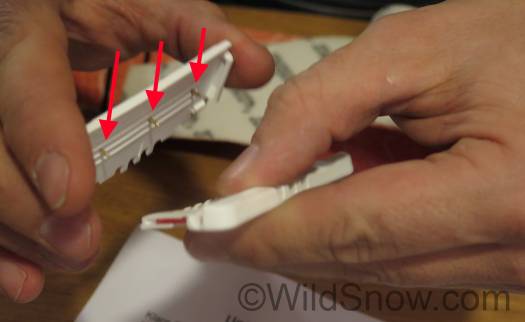
Tip clip is beautifully ingenious industrial design. The sharp pins hold the skin inside a plastic sandwich. Other than cutting the skin to proper shape, the process requires no tools other than your hand.
Tails attach with the usual friction slider over-center clip, only this one is hollowed out in the middle so it nests better over curved ski tails and resists sliding to the side. I’m not sure if Contour will offer a disposable off-set cutter like other brands, but their more dealer oriented cutting knife is the best I’ve seen.
In closing, I got a few tips in-person from contour regarding skin care. This applies mostly to their skins, but translates to others.
1. Skin glue can be UV sensitive; dry out of direct sunlight and don’t store on a hanger in your window.
2. Storing Contour skins glue-to-glue is totally ok in normal use, but a mesh liner is recommended for long-term storage.
3. Not all mesh liners are equal, some have chemical coatings or treatments that may impart to the skin glue. Contour’s are guaranteed to be pure.
4. With any brand, it’s possible that skin glue can be ruined by extreme heat in shipping containers. Thus, if you get a new pair of skins from any brand and they just are not right, be sure to warranty right away and consider the damaged glue might not be an inherent fault.
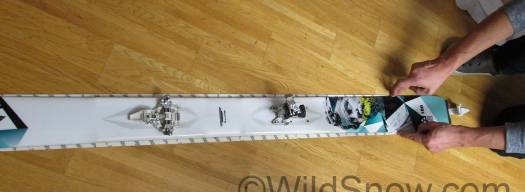
Centering skins on the ski is important for a good sidecut. I’ve always done this by just hanging the skin under the ski and pulling it tight. Contour owner Werner used the floor as an assist–good trick.
Where to get ’em in North America (easy in Europe)? CAMP USA is the importer of Contour skin products, they can find you a retailer or otherwise help you acquire. If anyone knows who the North American etailer is, please inform.
WildSnow.com publisher emeritus and founder Lou (Louis Dawson) has a 50+ years career in climbing, backcountry skiing and ski mountaineering. He was the first person in history to ski down all 54 Colorado 14,000-foot peaks, has authored numerous books about about backcountry skiing, and has skied from the summit of Denali in Alaska, North America’s highest mountain.

